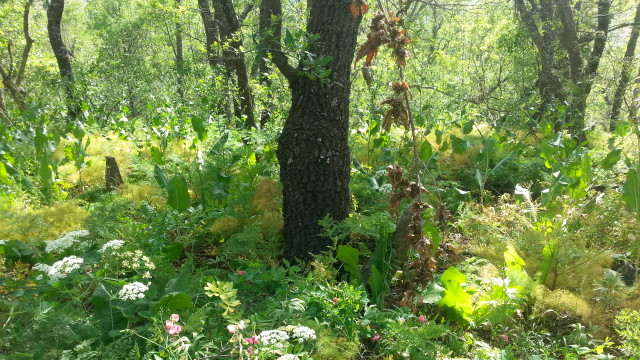This page contains automatically translated content.
Sacred sites ensure preservation of biodiversity in Iran
 Image: Zahed Shakeri.
Image: Zahed Shakeri."All over the world, communities place small parts of local landscapes under protection for religious reasons - whether in Ethiopia, Morocco, Italy, China or India," reports Prof. Dr. Tobias Plieninger, head of the Department of Social-Ecological Interactions in Agricultural Systems at the Universities of Kassel and Göttingen. Natural sacred sites are places where traditional myths and stories, local ecological knowledge and environmental protection meet. Beyond state protection programs, they form a network of informal nature reserves.
In the borderlands of Iran and Iraq, state conservation programs are often doomed to failure, while natural resources are under high pressure. Even in such conflict areas, thanks to traditional conservation practices, isolated species-rich forests exist in the form of decades-old sacred natural sites, including so-called 'sacred groves'.
Biocultural hotspots
Sacred groves are widespread in the Middle East, but have received little attention as biocultural hotspots. They usually belong to mosques and serve as cemeteries whose use is strictly regulated. While they often constitute a small area averaging about one hectare, they are rich in biodiversity, provide numerous ecosystem services, and are of great cultural and spiritual importance to local communities.
By local residents, they are seen as dwelling places of the souls of their ancestors. For example, Dr. Zahed Shakeri, who accompanied the project as a post-doctoral researcher and grew up in the region, reports numerous myths and legends surrounding the sites that demand careful care and respectful treatment.
Taxonomic diversity
"Our research group developed a fascination with the botanical treasures of these sites," Plieninger says. In a vegetation study, she found that taxonomic diversity is much higher in sacred groves than in adjacent, managed areas. The composition of the vegetation is also fundamentally different.
"The 22 sacred groves studied contain 20 percent of the flora of the entire region. They also harbor numerous very rare and threatened plant species and provide complex ecological niches for endangered animal species," reports Zahed Shakeri. "Because of this taxonomic diversity, Sacred Groves can serve as an important complement to formal protected areas in the region and a starting point for their restoration."
Local values and taboos
Due to changes in property rights, population growth, and the weakening of traditional faith practices, the number and condition of sacred natural sites around the world are declining. Therefore, the subject of this research included local people's perceptions of sacred groves and the reasons for their good condition in the region studied.
Through interviews with 205 local people from 25 villages, the research group identified core motivations of the people for the protection of the areas: In particular, spiritual values, the preservation of spiritual and cultural heritage, and local biodiversity played a role. In addition, the importance of taboos became clear, which above all prohibit or severely restrict the use of natural resources (logging, hunting and grazing), road construction, but also general behavior in the sites.
Although these social values and taboos are considered relatively stable in Kurdistan province, interviewees repeatedly referred to the threatened situation of the groves in the region. In particular, the elderly and those with a rural location, women, and those with traditional lifestyles would commonly be seen as the keepers of these values and taboos. "Conservation programs could support these groups in defending and reviving their customs. Young, urban and modern-oriented people are at the same time an important target group for awareness-raising work," Shakeri summarizes.
Biocultural approaches
The Sacred Groves example shows that social dynamics and especially cultural values deserve increased attention in conservation, he said. "Biocultural approaches to conservation that take into account different worldviews and knowledge orders could translate social taboos and associated land use practices into socially acceptable and ecologically effective outcomes," Plieninger concludes.
More information
On the blog of the Social-Ecological Interactions in Agricultural Systems Research Group:
https://medium.com/people-nature-landscapes
Go to the English blog articles:
Sacred Groves in Kurdistan: Biodiversity, Locally Preserved
Sacred Groves as a Safe Shelter for Biodiversity and Culture in Kurdistan
Publications:
Plieninger, T., Quintas-Soriano, C., Torralba, M., Muhammadi Sammani, K., & Shakeri, Z. 2020. Social dynamics of values, taboos and perceived threats around sacred groves in Kurdistan, Iran.. People and Nature 2: 1237-1250.
Shakeri, Z., Mohammadi-Samani, K., Bergmeier, E. & Plieninger, T. 2021. Spiritual values shape taxonomic diversity, vegetation composition, and conservation status in woodlands of the Northern Zagros, Iran.. Ecology and Society 26, art. 30.
Contact:
Prof. Dr. Tobias Plieninger
Head of Department Social-ecological Interactions in Agricultural Systems
E-mail: plieninger[at]uni-kassel[dot]de
Imke Horstmannshoff
Project Management & Communication
Department of Social-Ecological Interactions in Agricultural Systems
E-Mail: imke.horstmannshoff[at]uni-kassel[dot]de